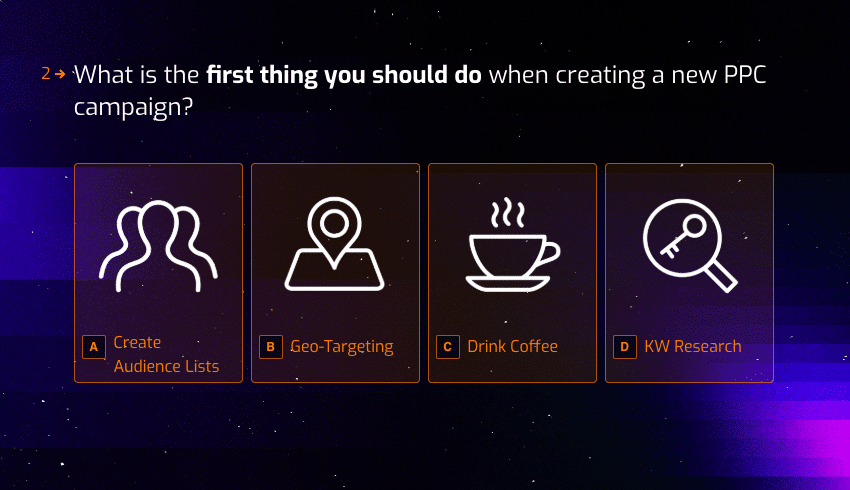At some point, everyone started thinking outside the box. Now that we’re all there, out in the open, it seems that all original content has been made. Where’s that promised creative space we would find when coloring outside the lines?
There is content that goes viral and commercials that leave you sobbing on your couch. While you have been consistently posting and have more ideas coming up, you might see engagement dropping on your content.
Time to spice things up. Every business and online brand can create original content, as long as it is clear who you are, and who your audience is.
Algorithm versus audience
The issue might not be the amount of content you want to create. Many social media channels won’t go a day without your content marketers uploading a new post, picture, or article. Because you don’t want the algorithm to punish you for your absence, we get that. But is that growing your content archives, or your actual client base?
Whereas algorithms like accounts that post regularly, they love accounts that post engaging content. Because we, the people, love it too. We share, comment, tag, and interact with it. So how do you create content that makes your audience stop in their tracks, interrupt the endless scrolling?
Strong content is surprising
Let’s take a step back and look at the content that’s out there. What does it do? What was its creator’s purpose, underlying message? Roughly speaking, it is either to educate or to entertain. But really memorable content comes with a plot twist: it delivers information in an unexpected way.

Before you start brainstorming, let’s go back to basics
Easier said than done, for sure. But you don’t necessarily need an abstract-thinking creative mind on your team or hours or coffee-fueled and post-it-filled brainstorming sessions. The quality of a painting relies heavily on its canvas, its foundation, so let’s look at some of the basics of content marketing.
- Look at your analytics: What has been working in the past? And what hasn’t? Cut that out. If that weekly social media post really hasn’t made that much difference, why spend any more time on making it?
- Know your audience: Don’t ask yourself what you want to tell, but what they want to hear, or see, or read. Which brings us to another important point: figure out in what format and through what channel you should deliver the message.
- Keep up with marketing trends: Dare to think outside the blog. Look at what other brands are doing: podcasts, GIFs, vlogs, Instagram courses, and Pinterest pages that speak to your imagination.
- Quality over quantity. Value over fluff: Don’t be a slave to your content calendar. The promise to post something every day is different than providing as much value as you can to your audience. Sometimes that means posting less and putting more time into one piece.
5 ways to spice up your content strategy
Now we’ve got our memories freshened up, let’s take a look at five ways to give your current content marketing strategy a boost: not just to create more, but to create better (more effective) content.
1. Same message – different format
Let’s say you write a weekly blog, but it has lost its spark, and it’s not as popular as it was before. If you still want to get your message across, consider wrapping it up in a different format.
How about making a video on this week’s topic? Having an actual person explaining something to you, when you can see and hear them, is a completely different experience than reading a 1000-word article. It makes your brand more real and your content more memorable – because let’s face it: blogs and text posts all look alike (guilty, yes).

Let’s get visual, visual
If you are not like Olivia Newton-John and don’t feel comfortable in front of a camera, or you just like switching things up when it comes to visual content. In that case, infographics are the way to go. Our human brains process visual data 60,000 times faster than text.
If you want to use visuals to entertain, rather than educate, look at the endless possibilities GIFs hold. They are fun, quick, relatable, and people tend to share or comment on them, creating a snowball effect of views.
2. Switch places with your audience
When brainstorming content, many businesses – understandably – think about what’s been going on and what they’ve been working on lately. Meanwhile, a whopping 80% of customers say they feel companies don’t understand them.
Instead of putting out a newsletter or the obligatory Facebook post on this week’s happenings at the headquarters, try asking your audience what it wants to share with you.
The power of social proof
There are many ways to involve your audience or customers in your content. Whether it is through co-creation, customer interviews, or showcasing user-generated content, viewers will recognize parts of themselves in these fellow buyers, rather than having to take the word of the seller. Meanwhile, your customer can revel in the exposure.
Interactive content and gamification
Content that focuses on opening a dialogue with your audience also opens doors for lead generation and personalization. A piece of content your viewers can interact with, not just look at, grabs their attention, and will create the feeling they’re being heard, rather than targeted.
For instance, creating a quiz is a fun way for your audience to interact with you. You can give them valuable information on your products based on their wishes, knowledge, and personality, and they might give you their email address in return. The average lead magnet quiz has a 40-50% lead capture rate, so it’s definitely worth the while.

For example: you are an expert in online marketing, and send out weekly articles about it. But on social media, these don’t seem to be appealing and attracting many readers.
Think the other way around: instead of writing a blog on PPC campaigns, put that knowledge in a fun format. Before giving all the information your audience needs, why not test what they know so far?
Content doesn’t always have to directly lead to a purchase. If you replace the call to actions with a fun message or a question, your audience can really engage with your posts. It also makes you more likable, and with overflowing markets, that is more valuable than ever.
3. Define your brand voice
When creating content, it’s easy to get lost in finding something you want to say, rather than focusing on how you want to say it. If you want to boost your content strategy, sometimes it doesn’t even require new pieces of content — just a better way of wording the existing ones.
Branding is more than using the right colors and polishing up your visuals. With a recognizable tone of voice, your stories will stick better. A strong tone of voice even makes smaller messages (that don’t hold world-changing news) worthwhile and stand out.
Finding your voice
The most effective and popular writing coming from businesses has one thing in common: it is human. Even when creating content for the B2B market, keep in mind that your reader will most likely be a human being, made of flesh, blood, and, most importantly, emotions.
Every brand should have a different tone of voice based on their own values, culture, and target group. Another way of approaching establishing a tone of voice is by listening to the customer’s voice and using this as a baseline: a foolproof way of connecting with your audience.

4. Offer a complete experience
One piece of great content that goes viral is great, except it isn’t. Spicing up your content strategy should mean creating an immersive experience.
Like eating a spicy Indian meal from a food vendor somewhere in Delhi: its smell, the sounds, taste (hot!), sweating (because: hot!), and a little bit of confusion (is that a dog driving a scooter?).
Like we said, an experience. Something that keeps people coming back.
Make sure that everything is in place and tidy after your audience clicks on your next amazing piece of content and goes to your website. Consistency is key, and having a clearly mapped out customer journey with the right pieces of content along the way is a real game-changer.
This is also part of creating a completely personalized (online) shopping experience. Show visitors content that is relevant to them, and you will be rewarded: 80% of shoppers are more likely to buy from a brand that offers personalized experiences than from those who don’t, and they will keep coming back, making it a great tool for customer retention.
5. Dive deeper
A lot of social posts only scratch the surface. By creating content with more educational value, you can strengthen your position as an authority or expert in your market. Create a whitepaper, e-book, or even an Instagram course. You can also quickly identify valuable leads when seeing who interacts with these pieces of content.
Ready to spice things up?
Creating content and consuming it should be equally fun: that’s the sweet spot where you know you’re doing it right. Put yourself in the shoes of your audience, don’t be afraid to get personal and watch the magic unfold.


